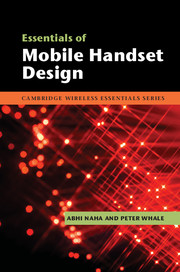8 - Conclusion
Published online by Cambridge University Press: 05 October 2012
Summary
From the first mobile telephone call on a street in Manhattan, New York, in 1973, through to the six billionth mobile phone connection just short of 40 years later, the mobile handset has transformed our ability to communicate and connect. Its level of sophistication is astonishing, yet it has weaved its way so inextricably into the fabric of modern life that it is already challenging to think of how we ever survived without these devices. The next 40 years are sure to be just as exciting a journey, as the handset increasingly becomes our fundamental tool for interacting with people, information and things, both in the real world and the virtual world.
We have taken you on a journey from the early history to the foreseeable future of mobile handset design. Along the way, we have covered all of the key areas of handset architecture and technology design, and uncovered the most important drivers and influences on mobile handset design.
Advances in electronics following the invention of the transistor, at a pace described by Moore’s Law, have led to what we might call the “more laws” of: more processing power, more miniaturization, more complexity, more economies of scale, more market growth, more market diversity, more utility value, more apps – and ever more mobile handsets! However, counter-balancing these “more laws” are the unbending physical world constraints of limited spectrum availability, limits on the achievable information transfer through a communications medium and limits on the chemistry of batteries and the resultant battery capacity. In addition, there are practical limits on human cognitive load and manual dexterity which affect our ability to interact successfully with small physical devices that are becoming more and more complex.
- Type
- Chapter
- Information
- Essentials of Mobile Handset Design , pp. 226 - 228Publisher: Cambridge University PressPrint publication year: 2012



